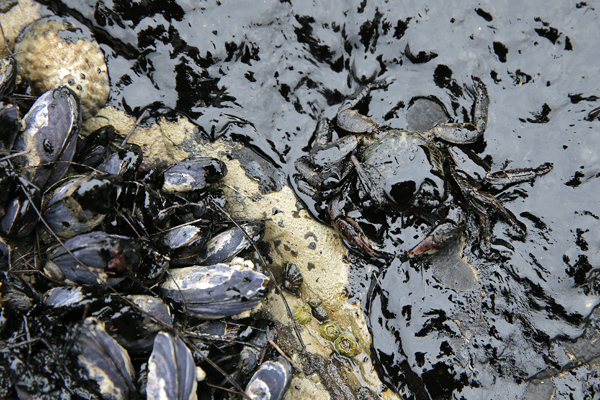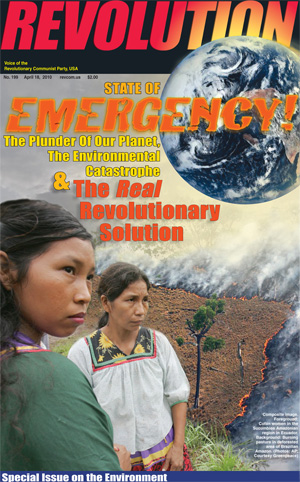Santa Barbara Oil Spill:
A Beautiful Coast Fouled, a Pattern of Destruction
June 8, 2015 | Revolution Newspaper | revcom.us
The ecosystems along the coastline north of Santa Barbara have been described as the “Galápagos of the North.” This is a beautiful coast bursting with marine life that has now been fouled by tens of thousands of gallons of crude oil. Forty miles of beach has been impacted by the spill. Oil slicks have been spotted 11 miles out in the ocean; pancake-like tar balls dot the surface in places.

The area along the Santa Barbara coast where the recent oil spill occurred is rich in marine life, such as these mussels and crab. (AP photo)
This week more pictures are coming out from the area. Seeing images of pristine beaches, now choked with oil, of dead dolphins, seals, sea and shore birds, and other organisms coated with oil is like a hard punch to the gut. And thinking about this new disaster in light of the overall relentless destruction of nature sickens the soul and enrages the heart and mind.
According to the Oiled Wildlife Care Network at University of California, Davis, School of Veterinary Medicine, 136 dead birds and 67 dead marine mammals had been found as of June 5. Dozens more have been oiled and attempts are being made to rescue them. But scientists have pointed out that many more animals that die will simply sink to the bottom and never be found. The danger to the area’s ecology is not just what can be seen on the surface. The oil is fouling ocean plants, being churned up by wave action, and mixing with sand so it can end up on the bottom affecting life there, and being dispersed elsewhere by wind and currents.
Scott Smith, Chief Scientist at Water Defense who has been testing the oiled area said on The Michael Slate radio show that he has found dangerous chemicals―carcinogens and endocrine disruptors―that are present in crude oil. Smith said: “You’ve got kelp out there and that oil and all the related toxic, cancer-causing chemicals are hung up in the kelp right now. The kelp is the food source for the food chain.” (See transcript of interview.) The impacts of this spill will be large and long lasting.
Oil Pipelines and Transport—A Pattern of Destruction
More information is coming out about the circumstances of the spill, the response from authorities and citizens, as well as the backdrop of this oil spill in the larger context.
It’s come out that the pipeline, owned by Plains All American Pipeline, was the only pipeline in Santa Barbara County that lacked an automatic shutoff valve. Having such a valve in place would have much more quickly stopped the flow of oil and possibly prevented it from getting into the ocean. The pipe ruptured near a beach and then poured “like a small river of oil” according to witnesses, for as long as two hours. An estimated 105,000 gallons poured out, 21,000 ending up in the ocean. The reason no shutoff valve was in place? Plains All American had successfully fought in court to prevent installing this valve on the grounds that the county couldn’t regulate the pipeline, since it was interstate and therefore subject only to federal authority.
Plains All American is listed by the federal government as the fifth worst violator in reporting safety and maintenance infractions. Since 2006, the company has had 175 infractions and caused more than 16,000 barrels (672,000 gallons) of oil to spill, causing $23 million in damage. Despite this, the company is still allowed to operate by the Obama administration and the entire system. On June 4, it was reported that the ruptured pipeline had almost half of its metal wall eaten away by corrosion.
The federal agency with ultimate responsibility for inspecting and guaranteeing the safety of this and the rest of the country’s pipelines, the Pipeline and Hazardous Materials Safety Administration (PHMSA), has only 139 inspectors and 300 “state partners” to inspect and regulate 2.5 million miles of pipelines.
Since 1995, there have been more than 2,000 significant accidents involving petroleum pipelines. The Center for Biological Diversity reports that since 1986 there have been 600 oil and gas pipeline leaks in California that have caused $769 million in damages as well as 200 injuries and close to 50 deaths.
And this whole pattern is increasing under Obama, the “environmental president.” The Associated Press reported that as U.S. oil production has boomed, pipeline accidents have increased in step, going up almost 60 percent since 2009. This doesn’t include all the accidents from other forms of transportation of fossil fuels―such as shipping oil by train, which has led to horrific explosions in Lac-Mégantic Quebec and elsewhere.
This new Santa Barbara spill comes after a giant oil spill that devastated the Santa Barbara coast in 1969. It comes after the Exxon Valdez spill in Alaska that killed off so much life, some of which has never returned; after an Enbridge pipeline ruptured dumping a million gallons into the Kalamazoo river in 2010, much of which still lies in the river bottom; after a pipeline rupture in Mayflower, Arkansas, poured thousands of barrels into a neighborhood and surrounding wetlands; after oil spilled into the Yellowstone River, twice; and after the Gulf oil disaster where more than five million barrels flooded the Gulf of Mexico, causing untold impact. And now, Obama has opened up the Arctic for drilling, opened a pathway for another potential catastrophe by oil spill and climate pollution. This new spill is not another “aberration” or “mistake,” but part of a continuing pattern of mass destruction.
Response of People and the Authorities
When the oil spill hit, all kinds of ordinary people threw on gear, grabbed buckets and shovels, and rushed to the beaches, desperate to do whatever they could to prevent as much damage as possible. When they arrived, there was little or no visible response from the authorities or the company, which supposedly had reams of plans for dealing with such a disaster. Instead, people set to work themselves. Some of them were threatened with arrest by cops for working without proper safety gear. Despite the real health risk, they felt they needed to do whatever they could to clean up because no one else was. Some beaches hadn’t received any official cleanup activities even after 18 hours. One responder said: “There’s a system here that’s broken, just like that pipeline is broken.”
Reports in the Santa Barbara Independent say that now the affected area is under strict control of federal and state agencies that have “imposed such exceptionally strict closures that volunteers, reporters and even area biologists have been denied access.” FAA flight restrictions are in place, as they were during the Gulf disaster. Greg Helms with the Ocean Conservancy said, “all the secrecy suggests there’s a big problem,” and speculated that more wildlife may have been killed and damage done than officials are admitting.
People deeply care in this area about the coast and environment. On May 31, 500 people marched in Santa Barbara protesting the oil spill and took a “stand in the sand” along Santa Barbara’s West Beach.

This Revolution special issue focuses on the environmental emergency that now faces humanity and Earth’s ecosystems. In this issue we show:
- the dimensions of the emergency...
- the source of its causes in the capitalist system, and the impossibility of that system solving this crisis...
- a way out and way forward for humanity—a revolutionary society in which we could actually live as custodians of nature, rather than as its plunderers.
Read online....
Also available in brochure format (downloadable PDF)
Why is it that people can see a need and respond to save the environment in short order, but that those with all the means at their disposal, those who run this system, cannot? Why is it that the tremendous potential that exists among people to protect nature is never mobilized by this system, but instead dealt with as a problem to control, as the system lumbers ahead to the next catastrophe?
The circumstances that led to this spill and all the others don’t demonstrate the problem is one of “too cozy a relationship” between government and oil companies or the need simply for more safety regulations and oversight.
What this demonstrates is that despite all the lies and repeated pronouncements of the capitalist authorities, from Obama on down, that oil drilling and transport can be done safely for the environment; this is just bullshit. After every disaster, it’s promised that new rules and regulations will solve the problem. And they never do. Remember, this was all supposed to have been taken care of by Obama’s administration after the Gulf oil spill. This is because this system is not capable of basing its decisions and its priorities on the long term interests of the environment or humanity, but instead is driven by “profit in command” and competition to expand or die. This sharply, achingly, proves again the illegitimacy of capitalism, its inability to do anything but proceed with its “business as usual” destruction of the environment.
When this is connected with the fact that it is completely unnecessary that destruction of life like this continues on and on, one becomes even more enraged. People must know: there is a science-based plan, approach and vision for a new socialist system that would protect and enhance the natural world and work to counter the destruction of capitalism. Rage and deep upset, as well as great love for nature, can be mobilized and also transformed into resistance, and for working for the only thing that can actually save our planet, organizing for an actual revolution.
Volunteers Needed... for revcom.us and Revolution
If you like this article, subscribe, donate to and sustain Revolution newspaper.








